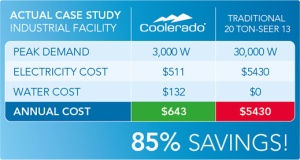Also discussed here: Snow, ice data center wins cool sustainability award (Elizabeth Lock, Colorado Arts and Sciences Magazine, Nov 2011)
And here: NSIDC Green Data Center
And here: Real-Time Monitor- NSIDC Green Data Center
And here: Coolerado
This technology , based on known scientific principles, cuts the need for electrical power used for air conditioning by 90% and has already been demonstrated (and won a national energy award) for the large amount of cooling needed for a large computing data centre in Colorado. It could be the solution for mitigating the part of climate change that comes from heating/cooling homes and buildings- especially in sunny, hot dry areas where cooling of buildings is so needed and where evaporative cooling works best. The other major emitter of greenhouse gases is transportation and the carbon-fuel burning vehicles which has been the focus of this blog.


Key Quotes:
“An evaporative cooler produces effective cooling by combining a natural process - water evaporation - with a simple, reliable air-moving system. Fresh outside air is pulled through moist pads where it is cooled by evaporation and circulated through a house or building by a large blower. As this happens, the temperature of the outside air can be lowered as much as 30 degrees.
“Since water is continually lost through evaporation, a float valve - much like the one that controls the water in a toilet tank - adds water to the sump when the level gets low. Under normal conditions, a swamp cooler can use between 3 to 15 gallons of water a day.”
“Evaporative coolers are now on the market that use photovoltaic panels to create the electricity used to run the blower and the water pump. For hot, desert areas, the combination of evaporative cooling and solar power are a perfect match”
“The Green Data Center project..shows NSIDC's commitment to reducing its impact on the environment, and that there is significant opportunity to improve the efficiency of data centers in the U.S. The heart of the design includes new cooling technology that uses 90 percent less energy than traditional air conditioning, and an extensive rooftop solar array that results in a total energy savings of 70 percent”
“as of 2006, U.S. data centers were estimated to consume 61 billion kilowatt hours of electricity, equivalent to the electricity consumed by 5.8 million average U.S. households. By 2020, the carbon footprint of data centers will exceed the airline industry”
Related articles
- Facebook achieves LEED gold for Oregon data center - GigaOm (gigaom.com)
- Amazon's New Data Center Could Save You Money (informationweek.com)
- Coolerado Chills Snow & Ice Data Center (datacenterknowledge.com)
- Evaporated water can cool surface of earth: report (thehindu.com)

No comments:
Post a Comment